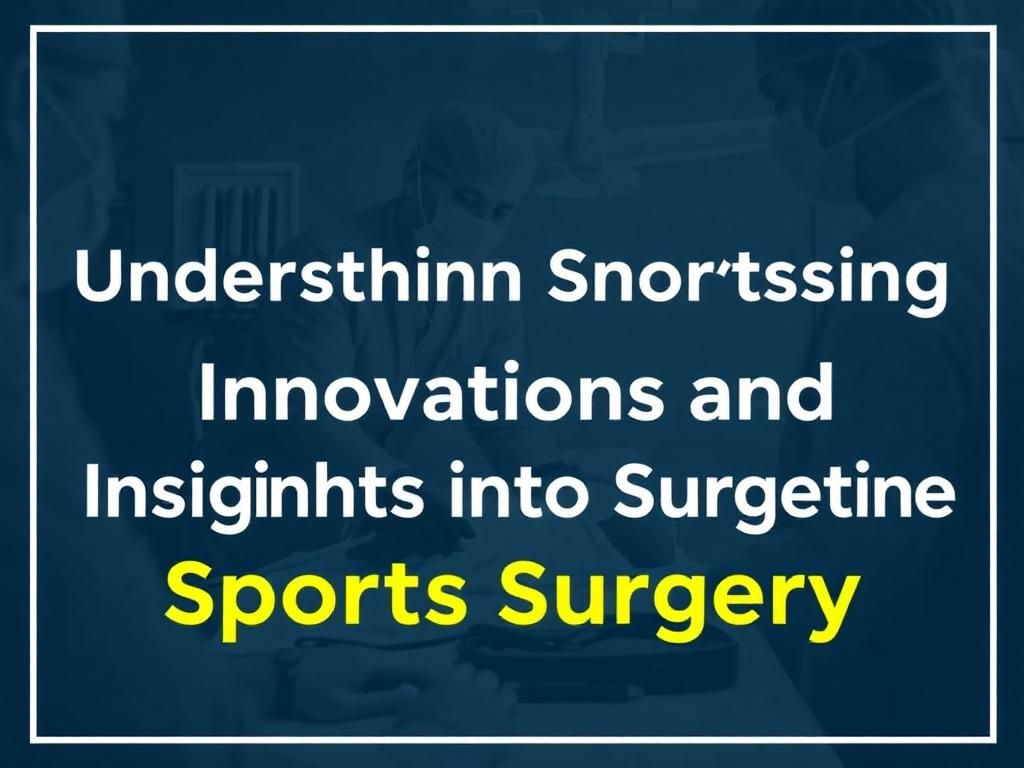Physical Address
304 North Cardinal St.
Dorchester Center, MA 02124
Physical Address
304 North Cardinal St.
Dorchester Center, MA 02124

The intersection of sports and medicine has led to remarkable advancements, particularly in the area known as sportsurgw. This term encapsulates the evolving field of sports surgery, which focuses on the surgical treatment of sports-related injuries. With athletes pushing their physical limits, the need for effective surgical interventions has never been critical. The relevance of sportsurgw has amplified, as it combines innovative surgical techniques with emerging technologies to enhance athletic performance and recovery.
The purpose of this article is to delve into the innovative aspects of sportsurgw and illuminate how advancements in technology and techniques are shaping the landscape of professional sports. From understanding common injuries to exploring future trends, we will cover a comprehensive spectrum of information that sports enthusiasts, athletes, and medical professionals should know.
Sports surgery is a specialized branch of medicine that focuses on diagnosing and treating injuries commonly sustained during sports activities. Sports surgeons possess extensive training in orthopedic surgery and often work closely with athletic programs, teams, and rehabilitation specialists to ensure optimal care for athletes.
The role of sports surgeons is multifaceted. They not only perform surgeries but also play a crucial role in injury prevention, recovery strategies, and rehabilitation protocols. Their expertise is vital for athletes aiming to return to their sport stronger and healthier.
Many injuries can occur in the realm of sports, and some of the most common ones include:
– **ACL tears**: Common in sports requiring sudden stops and changes in direction.
– **Fractures**: Often result from impacts or falls.
– **Rotator cuff injuries**: Frequent among athletes engaged in overhead sports, like baseball or tennis.
Statistics reveal that these injuries can have a significant impact on athletes’ careers, with **ACL tears** occurring in about 100,000 cases annually in the United States alone.
Prompt surgical intervention in cases of sports injuries can have profound benefits. Early treatment can lead to shorter recovery times and less long-term damage, allowing athletes to return to their sport more quickly. Delay in care often results in complications, extended recovery, and a higher likelihood of re-injury.
Technological advancements have transformed how surgeries are performed. Minimally invasive surgeries, such as arthroscopy, allow surgeons to operate through smaller incisions, resulting in reduced recovery time and decreased surgical trauma. These techniques are coupled with structured return-to-play protocols that ensure an athlete’s safe reintegration into their sport.
Emerging technology plays a critical role in enhancing sportsurgw. For instance, wearables are increasingly used for injury prevention, monitoring athlete movements in real-time to identify potential risks. Moreover, 3D printing allows for custom implants tailored to individual athletes’ anatomies, improving surgical outcomes significantly.
The rehabilitation process is equally vital to successful recovery. New methods in physical therapy, such as those utilizing virtual reality (VR), are gaining traction. VR can create immersive environments for patients, helping them regain strength and confidence in their mobility through gamified rehabilitation exercises.

Numerous high-profile athletes have undergone successful surgeries that exemplify the benefits of sportsurgw. For example, professional football players like Adrian Peterson and the NBA’s Derrick Rose have both had notable surgeries that allowed them to return to competitive play with significant improvements in performance post-recovery.
These cases accentuate the lessons learned regarding recovery timelines, rehabilitation practices, and the psychological impact of returning to sport after significant injuries.
Examining the effectiveness of traditional surgical techniques versus modern approaches reveals compelling data. Modern minimally invasive methods tend to facilitate faster recovery times and higher patient satisfaction rates. Athletes who undergo arthroscopic procedures typically return to their sport in less time compared to those opting for traditional open surgeries.
| Surgical Technique | Average Recovery Time | Patient Satisfaction Rate (%) |
|---|---|---|
| Traditional Open Surgery | 6-12 months | 75% |
| Minimally Invasive Surgery | 2-6 months | 90% |
Ethical practices within sportsurgw also warrant discussion, particularly in the context of informed consent and patient autonomy. Athletes must understand the risks involved in surgical interventions, especially in high-stakes sporting environments where the pressure to return to play can cloud judgment.
Clear communication is paramount; sports surgeons must provide thorough explanations of the surgery, rehabilitation process, and any potential outcomes or complications.
Every surgical procedure carries risks, and understanding the balance of these risks against the potential rewards is essential. Complications such as infection, re-injury, or impaired performance can impact an athlete’s career and mental health. Addressing these risks through evidence-based practices and ongoing dialogue with athletes is crucial for ensuring the best outcomes.
Looking ahead, the field of sportsurgw continues to evolve, with numerous trends emerging. One significant trend is the use of predictive analytics, which employs data to anticipate injuries before they occur, allowing for preventive measures to be taken. These innovations could revolutionize how we approach sports injuries.
Another exciting frontier is the potential for regenerative medicine. Techniques such as stem cell therapy and platelet-rich plasma (PRP) treatments are garnering attention for their ability to promote healing and tissue regeneration, potentially reducing the need for invasive surgical interventions.
As the advancements in sportsurgw progress, the long-term implications for athletic careers are promising. Continuous improvements in surgical techniques, patient care, and rehabilitation processes could lead to enhanced expectations for recovery times and overall athletic performance within the next decade.
In summary, sportsurgw represents a vital area of specialization that integrates cutting-edge surgical techniques with technological advancements to optimize athlete health and performance. The landscape of sports surgery continues to change, with innovations continuously improving outcomes for athletic injuries.
As we look to the future, athletes are encouraged to engage with qualified sports surgeons proactively. The ongoing research and development within the field underscore the importance of collaboration and innovation in enhancing athlete health and career longevity.
Sportsurgw refers to the specialized practice of sports surgery that focuses on injuries related to athletic activities.
Common injuries include ACL tears, fractures, and rotator cuff injuries.
Early intervention can significantly reduce recovery time and minimize long-term damage.
Minimally invasive surgeries and improved return-to-play protocols are notable advancements.
Technology aids in injury prevention, surgical precision, and rehabilitation through wearables and advanced visualization techniques.
Yes, informed consent and risk management are critical ethical considerations in the field.
The future of sportsurgw includes predictive analytics, regenerative medicine, and ongoing innovations in surgical techniques.
Athletes should engage with qualified sports surgeons and stay informed about the latest advancements in sports surgery.
Rehabilitation technologies enhance recovery processes through innovative methods, including virtual reality applications.
Patient satisfaction reflects the effectiveness of surgical interventions and facilitates future advancements in the field.
For further information, check out the latest publications from the [American Journal of Sports Medicine](https://www.ajsm.org/) and the [National Athletic Trainers’ Association](https://www.nata.org/).